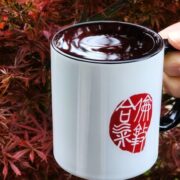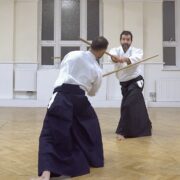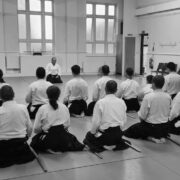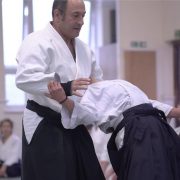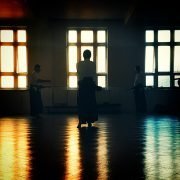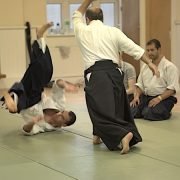No one wants to move

I like karate and other similar martial arts. Generally speaking there is a clarity in them. A no nonsense way of training that is something that Aikido these days seems to lack. When people are training, sparring in particular, they move and move appropriately to their system of training. The reasons are practical and not dressed in pseudo philosophical explanations or justifications. If you don’t move, you get hit, its as simple as that. The same goes for boxing, something which I also have a respect for. The weaving and bobbing and footwork are designed, when done well, to help roll with the punches. This is their ukemi and simply put you don’t get stuck when a punch or a kick comes your way. In Aikido so many speak of harmonising with the attacker, with their motion, to blend with it and deflect it. This is stated as the standard Aikido talk and yet it makes me wonder if any of those who speak in this way has considered what a competent strike is, a strong well placed kick and the damage it can do? I don’t think so. It gives Aikido a poor reputation and reduces it to ….I’m not sure what. One thing for sure and as a personal observation, people don’t want to move. How much of this is naivety and how much is other factors, social and cultural is a matter of debate. It does impact on the quality of Aikido out there.
Our society has taken on an interesting direction over the last few decades. It has become more static as a preponderance of service industries, IT and startups has come to dominate our lives. When we consider the Internet , smart phones and non stop movies online, then the inclination to move, physically but also mentally has become stilted. Comfort is another factor and probably the most significant one in which any impulse to push ourselves in sport, dance and general physical activity is diminished. I am not sure about the statistics, but here in London , there is apparently more physical activity than ever before. Yet the consensus on health, particularly amongst the under 30’s is an upward spiral in being over weight and even obese and growing dangerously so. There is also a collective concern on mental health, its impact on individuals, the young and society over time.
There is also civil rights and human rights. An incredible and hard earned addition to protect us and one which should not be taken for granted. These rights can however be interpreted negatively in the way they influence people. Often some people become a bit righteous and self important where even raising your tone, or insisting on something or the mildest of physical contact is construed as a violation of those personal rights. I believe this encourages separation, inertia and sometimes alienation. Not the stuff of community. This is not an attack on those rights, quite the contrary, but I think it is worth pointing out the collective influence of technology, a society primarily inclined towards service industries, the increase in comfort and the potential effect of civil and human rights to increase disengagement and a more self centred outlook. The outcome it seems is increased inertia, mentally and physically. The extent of these influences depends on the individual and the immediate environment. I am talking mainly from my experience in London and the U.K.
There are numerous essays on the human condition which indicate that regardless of our progress as a civilisation, beneath, we are still hunter gatherers in our physiological and emotional makeup. If we are to accept this then it is not difficult to realise that we were never designed to stay still in a chair or in front of a laptop etc. There are enormous benefits from all these developments I have described but my concern is the negative impact and how it effects what I do as an instructor. We pay a price for this as we numb or dull our senses, slow down or disconnect from our bodies and sometimes from others.
What does this all mean in the world of Aikido? We move a lot, there is near constant contact and sometimes instruction can be verbally stern , at the least assertive. This is great and a significant contrast to the more pedantic way of life . However, Aikido pertains to be a martial art, a Budo from Japan to be more precise. From this point of view, people struggle to move and I mean in particular the uke, the one taking the techniques, but also nage, the one throwing. Are we just moving dance like but lacking a deeper level of contact? A kind of beautiful choreography and delude ourselves into thinking we can deal with a substantial attack? The question is pertinent as when we throw someone the idea is to be effective. That is to get that person to the mat using an array of kata or forms. The question is how we get the uke to fall effectively which raises the question of taking their balance, which in turn forces the uke to deal with that loss of balance. Behind the technical side and the physics of movement is the energy associated with it. It is here where for me the crux of training today has lost that side. It is when done well daunting and sometimes scary. It is also where the avoidance of this has become the normal. Again it is interpreted as harmonious training but ends up as dull and ineffectual. Harsh words but maybe necessary. Aikido has been extracted out of the family of Budo and made into something else. This I think is a terrible shame as the very qualities that give it life, it’s fighting spirit, not to be confused with fighting, has been neutered. A good indicator of this is that many and quite possibly most people who do Aikido are not actually interested in martial arts as a whole. There is no curiosity in it and it is this same curiosity that allows someone to dig that little bit deeper to find the martial art in Aikido.
Aikido as a synergistic system of training is truly incredible. By synergy I mean the presence and exchange of energy and to deal with that. Yes , sometimes the energy is intense giving the forms not only life but an edge. Rather than avoid this, it should be encouraged and fully developed. All these forms from the front, grabbing, striking, from the back and kneeling. All designed to free up the endless possibilities in the students. It is the uke who is required to deal with this, to embrace it and understand it through their bodies. It is the loss of balance, when you are tipped over that point of control that the uke is challenged but also stimulated. Isn’t it the ability to recover from this that constitutes ukemi? Off balance not being merely a physical experience but also when the uke is unsettled sufficiently by other means. By atemi, by Kiai or by not knowing what is going to happen. My goodness, not knowing what is going to happen, that bit of uncertainty is the source of creative training. A bit of an adrenalin charge is ok.
As already stated, too much of training today falls short of this. From dance like flowing movements to acrobatics. It is impossible to throw anyone if no energy has been given. There is no movement. Some create the appearance of loss of balance by jumping around. The ukemi here is a product of throwing themselves rather than the outcome of correct movement. There is another issue, which is resistance to the move from the outset. Depending on why this is done it can become a hindrance in the long term. It stops the person doing the move and in fact stops the person doing it from learning how to move. It can escalate a situation to conflict or stifle a beginner from developing altogether. It doesn’t teach us to be the “weaker.” That’s right the weaker, which as a relative quality makes you more sensitive, more responsive. Underneath we need that life source to be active and alive. To sense movement and to be on our toes. The health giving by product of Aikido is obvious whichever way we train and that’s a good thing. But if no one wants to move when faced with some intent , some danger then the movements are not deep and under duress will most likely be superficial. Stuck, frozen or collapse follows rather than dealing with the force that comes to you. This should result in a resilient, centred and responsive individual. It has to be said that at times a student appears that has these qualities but chooses not to move. This is not because they can’t but because they don’t want to train in that way and that has to be accepted.

